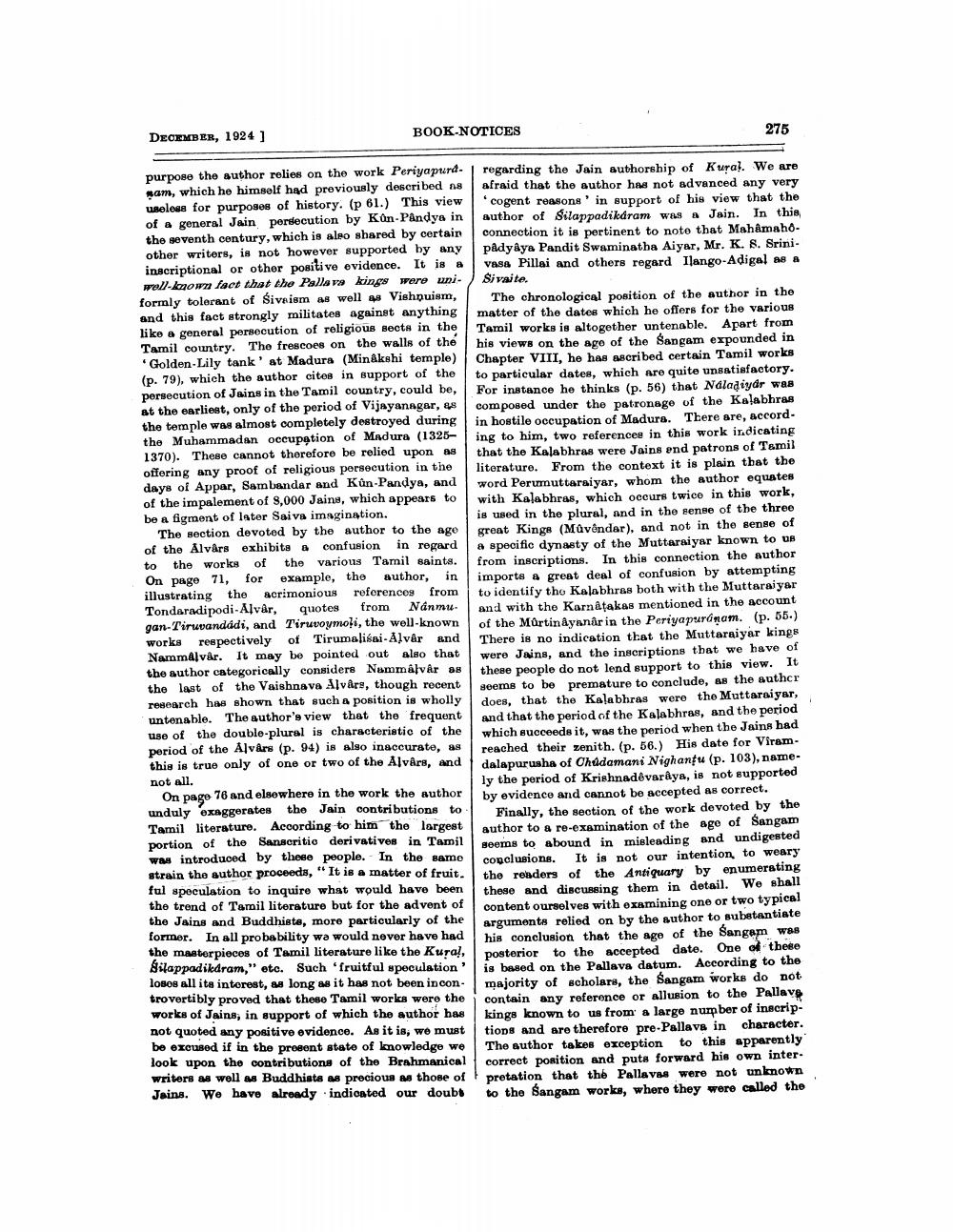________________
DECEMBER, 1924 ]
BOOK-NOTICES
275
purpose the author relies on the work Periyapurd. regarding the Jain authorship of Kura!. We are Ham, which he himself had previously described na afraid that the author has not advanced any very useless for purposes of history. (p 61.) This view cogent reasons in support of his view that the of a general Jain persecution by Kon-Pandya in author of Silappadikdram was Jain. In this the seventh century, which is also shared by certain connection it is pertinent to note that Msh&mahoother writers, is not however supported by any padyâya Pandit Swaminatha Aiyar, Mr. K. S. Srini. inscriptional or other positive evidence. It is a vasa Pillai and others regard Ilango-Adigal as a woll-known fact that the Pallare kings were uni Sivaite. formly tolerant of Sivaism as well as Vishnuism,
The chronological position of the author in the and this fact strongly militates against anything
matter of the dates which he offers for the various like a general persecution of religious sects in the Tamil works is altogether untenable. Apart from Tamil country. The frescoes on the walls of the
his views on the age of the Sangam expounded in Golden-Lily tank' at Madura (Minakshi temple) Chapter VIII, he has ascribed certain Tamil works (p. 79), which the author cites in support of the
to particular dates, which are quite unsatisfactory. persecution of Jains in the Tamil country, could be, For instance he thinks (p. 56) that Naladiyar was at the earliest, only of the period of Vijayanagar, es composed under the patronage of the Kalabhras the temple was almost completely destroyed during in hostile occupation of Madura. There are, accord. the Muhammadan occupation of Madura (1325- ing to him, two reference in this work indicating 1370). These cannot therefore be relied upon as that the Kalabhras were Jains end patrons of Tamil offering any proof of religious persecution in the literature. From the context it is plain that the days of Appar, Sambandar and Kän.Pandya, and
word Perumuttaraiyar, whom the author equates of the impalement of 8,000 Jains, which appears to with Kalabhras, which occurs twice in this work, be a figment of Ister Saiva imagination.
is used in the plural, and in the sense of the three The section devoted by the author to the age great Kinga (Mûvêndar), and not in the sense of of the Alvårs exhibits a confusion in regard a specifio dynasty of the Muttaraiyar known to UR to the works of the various Tamil saints. from inscriptions. In this connection the author On page 71, for example, the author, in imports a great deal of confusion by attempting illustrating the acrimonious references from to identify the Kalabhras both with the Muttaraiyar Tonderadipodi-Alvår, quotes from Nanmu. and with the Karnatakas mentioned in the account gan-Tiruvandadi, and Tiruvoymoli, the well-known of the Märtinâyanar in the Periyapuranam. (p. 55.) works respectively of Tirumaliśai-Alvâr and
There is no indication that the Muttaraiyar kinge NammAlvâr. It may be pointed out also that were Jains, and the inscriptions that we have of the author categorically considers Nammalvar as
these people do not lend support to this view. It the last of the Vaishnava Alvåre, though recent
seems to be premature to conclude, so the author research has shown that such a position is wholly
does, that the Kalabhras were the Muttaraiyar, untenable. The author's view that the frequent
and that the period of the Kalabhras, and the period use of the double-plural is characteristic of the
which succeeds it, was the period when the Jaina had period of the Alvars (p. 94) is also inaccurate, as
reached their zenith. (p. 56.) His date for Virsmthis is true only of one or two of the Alvârs, and dalapurusha of Chudamani Nighantu (p. 103), namenot all.
ly the period of Krishnadevarêya, is not supported On page 76 and elsewhere in the work the author
by evidence and cannot be accepted as correct. unduly exaggerates the Jain contributions to
Finally, the section of the work devoted by the Tamil literature. According to him the largest
author to a re-examination of the age of Sangam portion of the Sanscritic derivatives in Tamil
seems to abound in misleading and undigested was introduced by these people. In the same
conclusions. It is not our intention to weary strain the author proceeds, " It is a matter of fruit.
the readers of the Antiquary by enumerating ful speculation to inquire what would have been these and discussing them in detail. We shall the trend of Tamil literature but for the advent of content ourselves with examining one or two typical the Jains and Buddhiste, more particularly of the
arguments relied on by the suthor to substantiate former. In all probability wa would never have had
his conclusion that the age of the Sangam was the masterpieces of Tamil literature like the Kural,
posterior to the accepted date. One of these Silappadikdram," etc. Such 'fruitful speculation'
is based on the Pallava datum. According to the losos all its interest, as long as it has not been incon majority of scholars, the Sangam works do not trovertibly proved that these Tamil works were the contain any reference or allusion to the Pawa works of Jains, in support of which the author has kings known to us from a large number of inscripnot quoted any positive evidence. As it is, we must | tions and are therefore pre-Pallava in character. be excused if in the present state of knowledge we The author takes exception to this apparently look upon the contributions of the Brahmanical correct porition and puts forward his own interwriters as well a Buddhista se precious as those of pretation that the Pallavae were not unlenown Jains. We have already indicatod our doubt to the Sangam works, where they were called the




